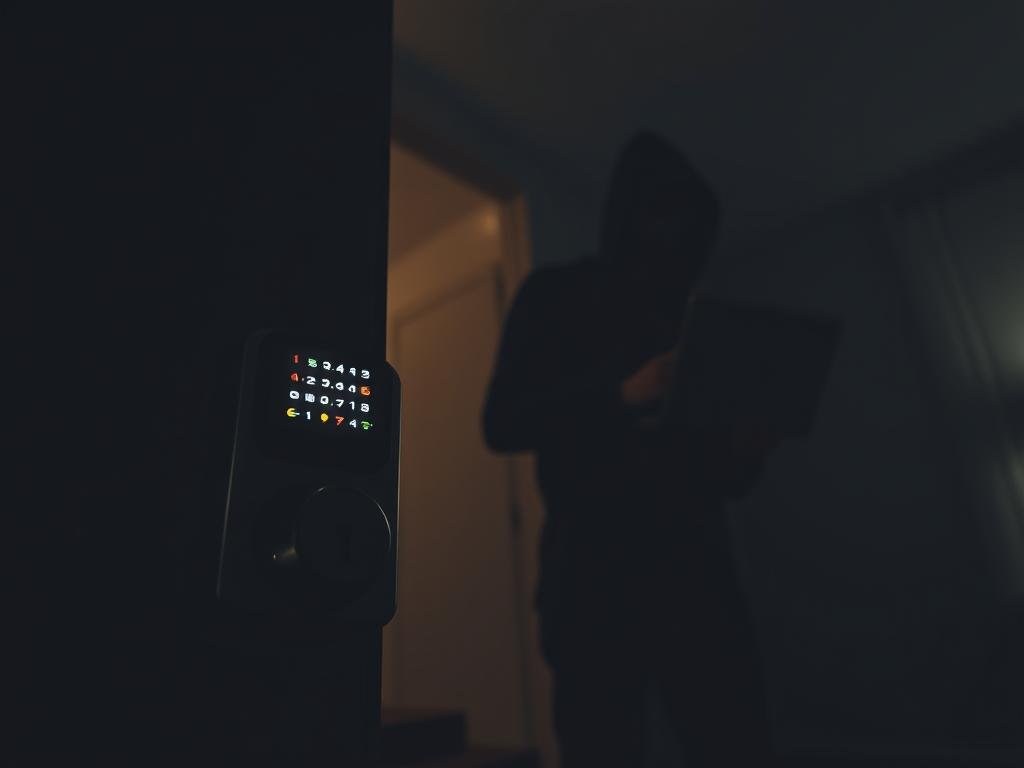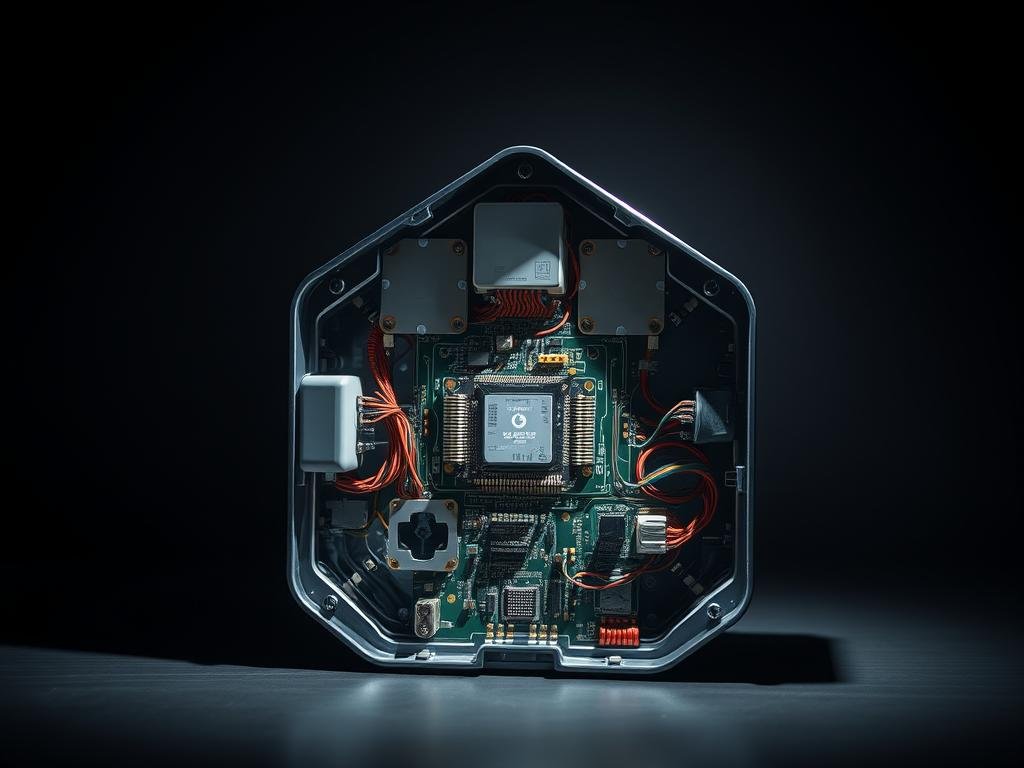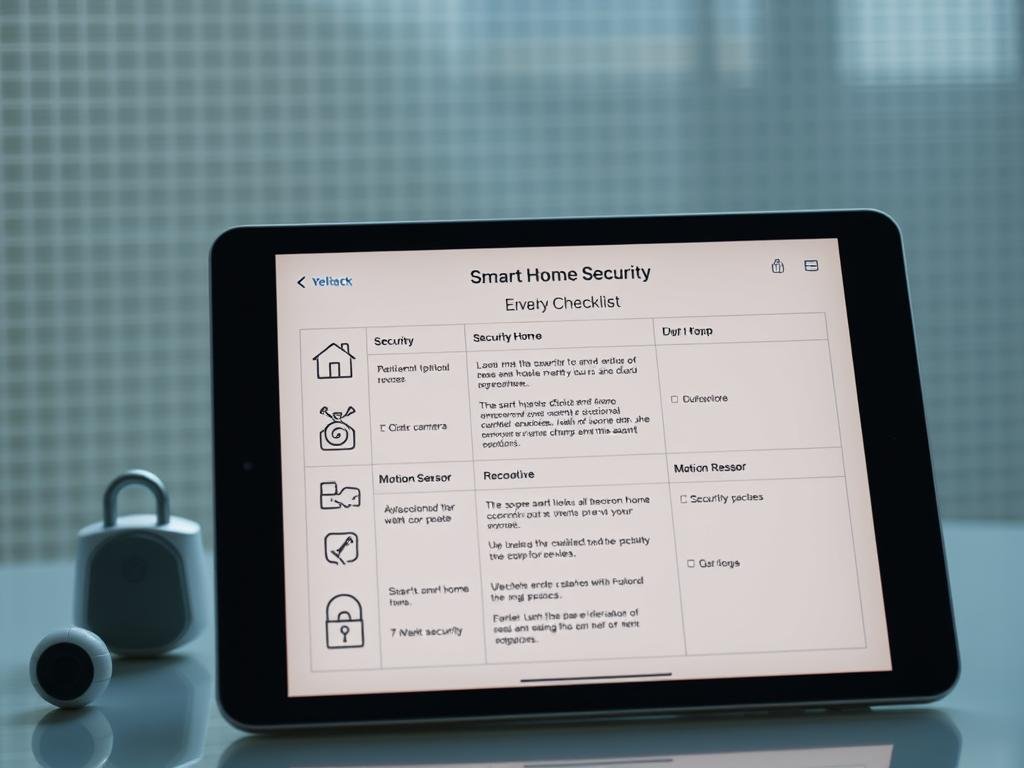Many popular smart devices can be hacked in under 10 minutes. This puts your personal data and home automation at risk.
Recent studies show hackers can exploit iot security risks in devices like routers and thermostats. This is because of weak passwords, outdated firmware, and other smart device hacking risks.
As we rely more on these devices, the risk of smart home security vulnerabilities grows. It’s important to understand these risks and protect your devices. For more on how hackers target routers, visit this resource to learn how to keep your home safe.
Key Takeaways
- Popular smart devices can be compromised in under 10 minutes.
- Weak passwords and outdated firmware are major contributors to iot security risks.
- Securing your smart devices is key to protecting your personal data.
- Regular firmware updates and strong passwords can help mitigate smart device hacking risks.
- Understanding smart home security vulnerabilities is key to safeguarding your home automation.
The Growing Threat to Your Smart Home Security
The smart home revolution has brought new security challenges. As you add more devices, you face many smart device hacking risks. Smart devices are convenient, but they also have vulnerabilities.
Why Smart Devices Are Vulnerable to Attacks
Smart devices connect to the internet, making them hacker targets. The IoT security risks include weak passwords and outdated firmware. Many devices have default passwords that hackers can easily guess.
Also, software updates are often slow, leaving devices open to attacks. For tips on securing your smart home, visit Building a Smart Home on a budget.
Our Testing Methodology and Expertise
Our team tested popular smart home devices using various methods. We tried to breach them with brute-force attacks and exploited known software vulnerabilities. Our knowledge in penetration testing helped us find weaknesses that hackers could use.
For more on smart home security, check out Smart Home Security: Security and Vulnerabilities. It offers detailed insights into the security challenges of smart homes.
To protect your devices, understand their vulnerabilities and set up a secure smart home setup. Update firmware regularly, use strong passwords, and be careful with what you share with your devices.
Smart Home Security Vulnerabilities: What You Need to Know
Smart home technology is becoming more popular. It’s important to know about security risks. Adding more devices to your network can make it easier for hackers to get in.
Common Attack Vectors Hackers Exploit
Hackers target weak spots in smart home devices. They use these to get into your network without permission. Here are some common ways:
- Weak passwords and authentication mechanisms
- Outdated firmware and software
- Unsecured communication protocols
Many smart devices have default passwords. If you don’t change them, hackers can easily get in.
| Attack Vector | Description | Mitigation Strategy |
|---|---|---|
| Weak Passwords | Default or easily guessable passwords | Change passwords; use strong, unique passwords |
| Outdated Firmware | Not updating device software regularly | Regularly update firmware; enable auto-update if available |
| Unsecured Protocols | Using insecure communication protocols | Use devices with secure, encrypted communication protocols |
The Real-World Consequences of Smart Home Breaches
A smart home breach can cause serious problems. Hackers can steal your personal info, mess with your daily life, and even cost you money. For example, a hacked thermostat can waste energy, and a compromised lock can let strangers in.
Protecting your smart home is key. Knowing how hackers work and taking steps to stop them can help a lot. This way, you can enjoy smart home tech without worrying about security.
Here are some quick things you can do:
- Change default passwords and use strong ones
- Keep your devices’ software and firmware updated
- Use secure communication and encrypt important data
Stay informed and take action. This way, you can have all the benefits of smart home tech while keeping it safe.
1. Smart Doorbell Cameras: Easy Entry Points for Hackers
Smart doorbell cameras are key to home security, but they have weaknesses hackers love. As they grow in use, knowing their security issues is vital for homeowners.
Ring and Nest Doorbell Vulnerability Analysis
Popular doorbell cameras like Ring and Nest have several security issues. These include weak passwords, old firmware, and poor encryption. Hackers can use these flaws to get into your camera’s feed, risking your home’s safety.
Key vulnerabilities include:
- Weak password policies
- Outdated firmware
- Insufficient data encryption
Vendor Response to Security Concerns
Ring and Nest have tackled security issues with updates and better security. But, it’s also up to users to keep their devices safe.
It’s essential for users to:
- Regularly update their device firmware
- Use strong, unique passwords
- Enable two-factor authentication
How to Secure Your Video Doorbell
To protect your smart doorbell, follow best practices and use the security tools offered by the maker. These steps can greatly lower the chance of your device being hacked.
Security measures include:
| Security Measure | Description |
|---|---|
| Strong Passwords | Use complex passwords and change them often |
| Two-Factor Authentication | Add an extra security layer to your account |
| Firmware Updates | Keep your device’s firmware current |
2. Smart Locks: When Your Digital Key Falls into Wrong Hands
Smart locks have changed home security, but they’re not perfect. They offer convenience and better security, but there are risks. It’s important to know these risks to keep your home safe.

August and Yale Smart Lock Security Flaws
Studies have found big security problems with August and Yale smart locks. Some models can be hacked, letting strangers into your home. Knowing these risks is key to keeping your smart home safe. Many smart locks don’t use strong encryption, making them easy targets for hackers.
Security experts warn that smart locks can be a trap for complacency. But, staying alert is critical, even in the world of ambient computing. Here, tech blends into our lives, sometimes hiding dangers.
Vendor Response to Security Concerns
August and Yale are fixing their smart locks after security issues were found. August has updated its firmware, and Yale has improved its encryption. It’s important to update your smart lock’s firmware to stay safe.
- Regularly check for firmware updates
- Use strong, unique passwords for your smart lock accounts
- Enable two-factor authentication when available
Protecting Your Smart Lock from Unauthorized Access
To keep your smart lock safe, use a strong password and enable two-factor authentication. Always update your smart lock’s firmware. Also, limit who can access your lock, like service providers or guests.
As security expert
“The key to securing smart locks lies in a combination of robust device security and user vigilance.”
By knowing the risks and taking steps to prevent them, you can make your smart home much safer.
3. Voice Assistants: Always Listening, Sometimes Leaking
Voice assistants like Amazon Echo and Google Home are everywhere. They listen all the time, ready to help with your voice. But this constant listening can also be a problem.
Amazon Echo and Google Home Vulnerability Assessment
Studies have found that voice assistants can be attacked in different ways. For example, Amazon Echo devices can be tricked into doing things without you knowing. Google Home devices can also be hacked, giving hackers access to your private info.
“Voice assistants are a big target for hackers because they always listen,” says a cybersecurity expert. “If a hacker gets into a voice assistant, they could get a lot of your personal info.”
Vendor Response to Security Concerns
Amazon and Google are working to make their devices safer. Amazon uses voice recognition to keep your info safe. Google updates its software regularly and uses better encryption.
- Regular software updates to patch vulnerabilities
- Improved data encryption to protect user data
- Enhanced user authentication mechanisms
Securing Your Voice Assistant Devices
To keep your voice assistants safe, there are a few things you can do. First, always update your device’s software. Also, check your voice assistant’s settings to make sure it doesn’t know too much about you.
- Use a strong password for your associated accounts.
- Enable two-factor authentication where possible.
- Regularly review and delete voice recordings stored by the device.
By knowing the risks and taking steps to protect your devices, you can use them safely. This way, you can enjoy their benefits without worrying about your smart home privacy.
4. Smart Thermostats: Temperature Control Hijacking
Smart home devices like thermostats are becoming more common. Models like Nest and Ecobee offer convenience and save energy. But, they also pose security risks.
Nest and Ecobee Security Weaknesses
Studies have found vulnerabilities in Nest and Ecobee thermostats. Weak passwords, outdated software, and unauthorized network access can all be security risks.
Some specific vulnerabilities include:
- Weak Authentication: Using a weak password or no two-factor authentication makes it easier for hackers to get in.
- Outdated Software: Not updating your thermostat’s software regularly leaves it open to known security issues.
- Network Vulnerabilities: An insecure home network can let hackers into your thermostat.
Vendor Response to Security Concerns
Nest and Ecobee have worked to improve security. Nest has added strong security features like regular updates and two-factor authentication. Ecobee has also enhanced security, including data encryption and alerts for suspicious activity.
But, users must also do their part. This includes using strong passwords and keeping devices updated.
Safeguarding Your Climate Control Systems
To keep your smart thermostat safe, follow these tips:
- Use Strong Passwords: Make sure your thermostat and app passwords are strong and unique.
- Enable Two-Factor Authentication: This extra step makes it harder for hackers to get in.
- Regularly Update Software: Keep your thermostat’s software current to avoid security issues.
- Monitor Your Network: Check your home network for any unusual activity or unauthorized devices.
By following these steps, you can greatly improve your smart thermostat’s security. This helps protect your home automation network from threats.
5. Security Cameras: When Watchers Become the Watched
Security cameras make us feel safer, but they also bring new risks. They are now a target for hackers because we rely on them so much.
Wyze and Arlo Camera Hack Demonstrations
Studies have shown big problems with Wyze and Arlo cameras. Hackers can get into these cameras and see what’s happening in your home.
Vulnerabilities in Wyze Cameras: Wyze cameras can be hacked because of weak passwords or old software.
Vulnerabilities in Arlo Cameras: Arlo cameras also have big security issues. Hackers can get into the camera’s settings and feed.
Vendor Response to Security Concerns
Wyze and Arlo have fixed some of these problems with new software updates. But, these updates only work if you keep your cameras updated.
- Wyze has sent out security updates and told users to update their cameras.
- Arlo has also updated their cameras and given tips on how to keep them safe, like changing passwords.
Essential Security Settings for Your Smart Cameras
To keep your smart cameras safe, follow these tips:
| Security Measure | Description | Benefit |
|---|---|---|
| Change Default Passwords | Update the default admin password to a strong, unique password. | Prevents unauthorized access. |
| Enable Two-Factor Authentication (2FA) | Activate 2FA to require a second form of verification in addition to your password. | Adds an extra layer of security. |
| Regularly Update Firmware | Keep your camera’s firmware up-to-date to ensure you have the latest security patches. | Fixes known vulnerabilities. |
By following these steps, you can make your smart cameras much safer. This will help protect your home from hackers.
6. Smart Hubs: The Central Point of Failure
Smart hubs are convenient but can be a weak spot in your smart home security. They act as the main control center, linking various smart devices. This makes them key to your home’s automation system.

Samsung SmartThings and Wink Hub Vulnerabilities
Popular smart hubs like Samsung SmartThings and Wink Hub have security flaws. A study found that some Samsung SmartThings hubs could face command injection attacks. This lets hackers run any command they want.
Wink Hub also has security issues, including a weak authentication system. This could let unauthorized users access the hub and connected devices.
Vendor Response to Security Concerns
Samsung and Wink have fixed these security problems with firmware updates. Samsung improved their SmartThings hub to stop command injection attacks. They did this by better checking user input.
It’s vital to keep your smart hub’s firmware updated. This ensures you have the latest security fixes. Always check for updates and apply them quickly to lower your risk.
Hardening Your Smart Home’s Command Center
To make your smart home’s command center more secure, follow these tips:
- Regularly update your smart hub’s firmware to ensure you have the latest security patches.
- Use strong passwords and enable two-factor authentication if available.
- Limit the number of devices connected to your smart hub and monitor their activity.
- Disable any features or services you don’t use to reduce the attack surface.
By following these steps, you can greatly improve your smart home’s security. This will help protect it from possible threats.
7. Smart TVs and Streaming Devices: Entertainment or Surveillance?
In today’s smart homes, TVs and streaming devices are more than just for fun. They can also be a way for hackers to get into your system. So, it’s important to know how these devices can affect your security.
Roku and Fire TV Stick Security Issues
Devices like Roku and Fire TV Stick have had security problems. Some have been hacked through bad apps or unauthorized access to your viewing history.
To stay safe, make sure your devices are up to date. Also, check the apps on your streaming devices often. Remove any you don’t use or don’t know.
Vendor Response to Security Concerns
Roku and Amazon have worked to fix these security issues. They’ve released updates and improved how they check apps. But, you should also be careful and protect your devices yourself.
Privacy Protection for Your Entertainment Systems
To keep your privacy safe, do a few things. Always check your device’s privacy settings. Use strong passwords and be careful with new apps. Also, limit the data you share with others and avoid targeted ads when you can.
By following these tips, you can enjoy your smart TV and streaming devices without worrying about security risks.
8. Smart Plugs and Switches: Backdoors to Your Network
Smart plugs and switches are often overlooked but can be a big risk in your smart home. These devices let you control your appliances from afar. But, if not secured well, they can be a doorway for hackers.

TP-Link and Wemo Switch Vulnerabilities
Brands like TP-Link and Belkin’s Wemo have security issues. Some TP-Link smart plugs can be taken over by attackers, posing network security threats. Wemo devices also face problems with their updates, making them vulnerable to attacks.
These weaknesses can be used in many ways, like cross-site request forgery (CSRF) attacks or weak passwords. If a hacker gets into your smart plug or switch, they can control your appliances. They might also disrupt your network or use your device to get into other connected devices.
Vendor Response to Security Concerns
When smart plug and switch vulnerabilities are found, vendors usually fix them with updates. For example, TP-Link has a team that works on fixing security problems in their devices. It’s key to keep your devices updated to avoid known issues.
You can find update info in the device’s app or on the manufacturer’s website. For more on keeping your network safe, check here.
Securing Your Smart Electrical Controls
To keep your smart plugs and switches safe, use strong, unique passwords for each. Always update your devices’ firmware. Also, think about using network segmentation to keep your IoT devices separate from your main network. This can stop a hacked smart plug from getting into your whole network.
Be careful with smart plugs and switches from unknown brands. They might not follow the same security rules as well-known brands. Always check a product’s security before buying. Think about the iot device security flaws it might have.
9. Smart Speakers: More Than Just Music Players
Smart speakers like Sonos and Bose are convenient but also bring risks. They are used for entertainment and information. It’s important to know their security risks and protect them.
Sonos and Bose Speaker Security Flaws
Studies have found security issues with popular smart speakers. For example, Sonos speakers can be hacked to listen in or control. Bose speakers have privacy and access issues. A report says smart device cyberattacks have doubled in recent years, showing we need to be careful.
Some security flaws include:
- Weak voice assistant integration that could let hackers give commands.
- Not enough encryption, making it easy for hackers to get personal info.
- Not good enough authentication, letting hackers get into settings and data.
Vendor Response to Security Concerns
Sonos and Bose have fixed some of these issues with updates. Sonos has better encryption and authentication. Bose has improved data protection and account security.
It’s important to update your devices regularly. This keeps them secure. Always check for updates and install them right away to lower risks.
Protecting Your Audio Devices from Intrusion
To keep your smart speakers safe, follow these tips:
- Update your device’s firmware often to get the latest security fixes.
- Use strong, unique passwords for your device and accounts.
- Limit what your device can access and adjust privacy settings.
- Watch your device for any odd behavior.
By following these steps, you can enjoy your smart speakers safely. As IoT security risks grow, staying informed and active is essential to protect your smart home.
Comprehensive Smart Home Security Checklist
To keep your smart home safe, you need a detailed security checklist. This checklist includes steps and regular tasks to guard your devices and data against threats.
Immediate Actions to Take Today
First, take steps to secure your smart home today. Change the default passwords on all devices and accounts. Use strong, unique passwords for each device. Consider using a password manager to keep them organized.
Enable two-factor authentication (2FA) wherever you can. This adds an extra layer of security.
- Change default passwords on all devices and accounts.
- Enable two-factor authentication (2FA) wherever possible.
- Update the firmware of all your smart devices to the latest version.
Weekly Security Maintenance Tasks
Regular upkeep is essential for a secure smart home. Every week, check for firmware updates and install them right away. Watch your network for any odd activity.
Also, review the list of connected devices to make sure no unauthorized ones are there.
| Task | Frequency | Importance |
|---|---|---|
| Check for firmware updates | Weekly | High |
| Monitor network activity | Weekly | High |
| Review connected devices | Weekly | High |
Monthly Security Audit Procedures
Every month, do a deep security check on your smart home. Review your security settings and look for any network vulnerabilities. Make sure all devices are set up right.

By sticking to this smart home security checklist, you can greatly improve your home’s security. This will help protect your IoT devices from threats.
Conclusion: Building a Truly Secure Smart Home
Popular smart home devices can be hacked, risking your personal data and security. To create a secure smart home, it’s vital to know the risks and take action. This includes understanding smart home security vulnerabilities and reducing IoT security risks.
By following a detailed smart home security checklist, you can make your home safer. It’s important to update your devices regularly, use strong passwords, and be careful with permissions. These steps help protect your smart home.
Keeping up with the latest security threats and best practices is essential. Being alert and taking the right precautions allows you to enjoy smart home benefits while keeping your data and security safe.
FAQ
What are the most common smart home security vulnerabilities?
Weak passwords, outdated firmware, and insecure data transmission are common issues. Hackers often target devices like doorbell cameras, locks, and voice assistants.
How can I protect my smart home from hackers?
Use strong passwords and keep your devices’ firmware updated. Also, use a secure network. Always check for security updates and use two-factor authentication when possible.
Are smart doorbell cameras secure?
Smart doorbell cameras can be hacked if not secured well. Make sure your camera has a strong password. Use encryption and two-factor authentication for extra security.
Can smart locks be hacked?
Yes, smart locks can be hacked. Choose a lock with good security features like encryption and secure authentication. Update your lock’s firmware regularly to avoid known vulnerabilities.
How can I secure my voice assistant devices?
Use a strong password and enable two-factor authentication. Regularly check your device’s activity. Be careful with voice commands and mute your device when not in use.
What are the risks associated with smart thermostats?
Smart thermostats can be hacked, giving unauthorized access to your home’s climate control. Use a strong password and update your thermostat’s firmware regularly.
How can I protect my smart security cameras?
Use a strong password and enable encryption. Update your camera’s firmware regularly. Consider using two-factor authentication and secure data transmission for extra protection.
What are the security risks associated with smart hubs?
Smart hubs can be a weak point in your smart home, allowing hackers to access many devices. Make sure your hub has strong security features like encryption and secure authentication.
Can smart TVs and streaming devices be hacked?
Yes, smart TVs and streaming devices can be hacked. Use a strong password and keep your device’s firmware updated. Be careful when installing apps.
How can I secure my smart plugs and switches?
Use a strong password and enable encryption. Update your device’s firmware regularly. Consider using two-factor authentication for extra security.
What are the security risks associated with smart speakers?
Smart speakers can be hacked, giving unauthorized access to your audio devices. Use a strong password and update your speaker’s firmware regularly.
How often should I perform a security audit on my smart home?
Perform a security audit on your smart home at least once a month. Check for firmware updates, review device activity, and ensure all devices are secured.
